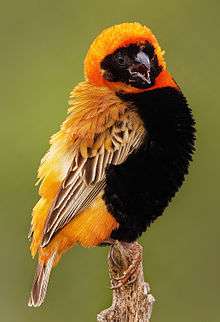Southern red bishop
The southern red bishop or red bishop (Euplectes orix) is a small passerine bird belonging to the bishop and widowbird genus Euplectes in the weaver family, the Ploceidae. It is common in wetlands and grassland in Africa south of the Equator. North of the Equator, it is replaced by the northern red bishop or orange bishop (E. franciscanus) which was formerly regarded as a subspecies of this species.
| Southern red bishop | |
|---|---|
 | |
| Male, breeding plumage | |
.jpg) | |
| Female perched on a reed | |
| Scientific classification | |
| Kingdom: | Animalia |
| Phylum: | Chordata |
| Class: | Aves |
| Order: | Passeriformes |
| Family: | Ploceidae |
| Genus: | Euplectes |
| Species: | E. orix |
| Binomial name | |
| Euplectes orix | |
| Synonyms | |
|
Emberiza orix Linnaeus, 1758 | |
Description
It is 10–11 centimetres long and has a thick conical bill. Breeding males are brightly coloured with red (occasionally orange) and black plumage. The forehead, face and throat are black and the rest of the head is red. The upperparts are red apart from the brown wings and tail. The upper breast and under tail-coverts are red while the lower breast and belly are black. The non-breeding male and female have streaky brown plumage, paler below. Females are smaller than the males.
It has various twittering calls and a nasal contact call. The male has a buzzing song.
Breeding males of the northern red bishop have a red throat, black extending further back on the crown and long tail-coverts which almost cover the tail. The females and non-breeding males are almost identical to those of the southern red bishop.
Distribution and habitat
It occurs from South Africa north to Angola, southern and eastern parts of the Democratic Republic of Congo,northern Zambia southern Uganda north-east Nigeria and south-west Kenya. It is largely absent from the Namib Desert and Kalahari.
In the breeding season it is found near water among grass, reeds, sedges or crops such as sugar cane. Outside the breeding season it will venture into drier grassland and savanna habitats.
Behaviour
.jpg)
It is a fairly gregarious bird, nesting in colonies and foraging in flocks. It feeds on seeds and some insects. It often roosts in mixed flocks with other members of the weaver family.
At the start of the breeding season, the males build several nests to attract females. They perform a display flight with their feathers fluffed up. They are polygynous and mate with several females. The nest is most commonly built among reeds and is made of grasses and other plant materials woven together. Two to four eggs are laid.
References
- BirdLife International (2012). "Euplectes orix". IUCN Red List of Threatened Species. 2012. Retrieved 26 November 2013.CS1 maint: ref=harv (link)
- Craig, A.J.F.K. Red Bishop. Avian Demography Unit. Accessed 31 December 2007.
- Dowsett-Lemaire, Françoise & Dowsett, Robert J. (2006) The Birds of Malawi, Tauraco Press & Aves, Liège, Belgium.
- Sinclair, Ian & Ryan, Peter (2003) Birds of Africa south of the Sahara, Struik, Cape Town.
- Zimmerman, Dale A.; Turner, Donald A. & Pearson, David J. (1999) Birds of Kenya & Northern Tanzania, Christopher Helm, London.
External links
| Wikimedia Commons has media related to Euplectes orix. |
| Wikispecies has information related to Euplectes orix |
- (Southern) Red bishop - Species text in The Atlas of Southern African Birds
- Southern red bishop species page on Weaver Watch
- African Bird Image Database: Southern red bishop
